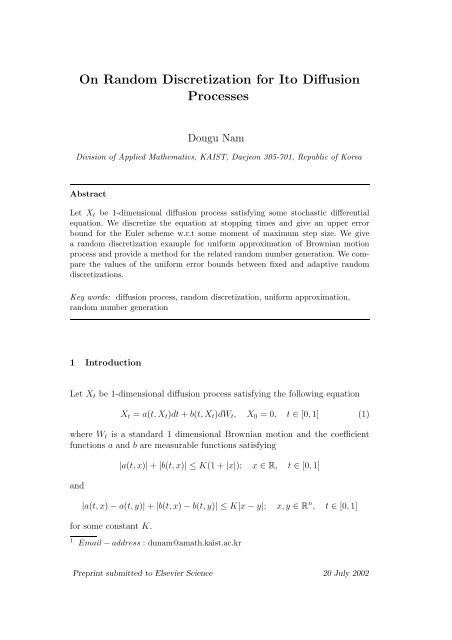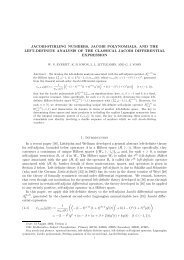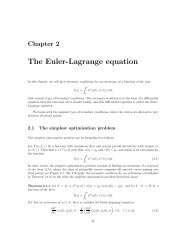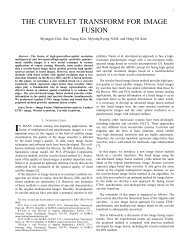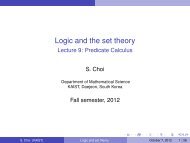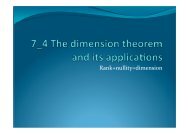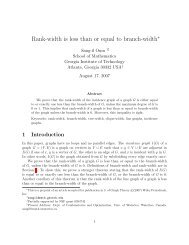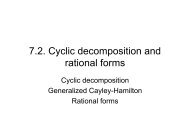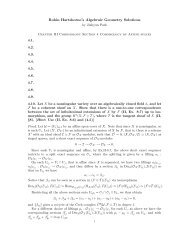On Random Discretization for Ito Diffusion Processes
On Random Discretization for Ito Diffusion Processes
On Random Discretization for Ito Diffusion Processes
You also want an ePaper? Increase the reach of your titles
YUMPU automatically turns print PDFs into web optimized ePapers that Google loves.
In the strong approximation of stochastic differential equations, we choosediscrete time steps and apply a numerical scheme with partial in<strong>for</strong>mation ofthe driving Brownian motion i.e. discretely observed Brownian motion andsome multiple stochastic integrals on each time subinterval. So, the time samplingis closely related to the quality of the approximation. Most commonlyused time discretization is equidistant one. But if we control the step sizesaccording to the local errors adaptively, we may reduce the error amount orsave some computational costs <strong>for</strong> a given allowed error bound - see [2] and[7]. Some general commentaries on random discretizations are found in [3] andthe predictability of the discretization times is emphasized <strong>for</strong> the recursivecomputation i.e., the n+1 - th time node τ n+1 should be A τn measurable <strong>for</strong> agiven filtration {A t } t≥0 . Also the deterministic upper bound <strong>for</strong> the maximumstep size is imposed <strong>for</strong> the convergence of numerical scheme. In recent years,asymptotically optimal discretization methods are developed by N. Hofmannat al. <strong>for</strong> pathwise global errors and linearly interpolated numerical solutions- see [4], [5], and [8]. We review them briefly here. Let X t be the solution of(1) and Ȳt be the linearly interpolated numerical solution. In [5], the followingglobal L 2 -norm error(∫ 1e(Ȳ [E ) =0)] 1/2|X t − Ȳt| 2 dtwas considered and the asymptotically optimal time steps are suggested as()hτ n+1 = τ n + min|b|(τ n , ¯X τn ) , h2/3 , h > 0.The convergence rate <strong>for</strong> this time discretization is also shown to be trulyoptimal among all approximations based on N measurable selection of observationsof the driving Brownian motion. In [8], d-dimensional system of SDEswith m-noise was considered with a different error criterion, global uni<strong>for</strong>mL p -norm error,e p ( ¯X) = (E||X − Ȳ ||p ∞) 1/p , p ≥ 1,where||X − Ȳ || ∞ = max max |X i(t) − Ȳi(t)|,t∈[0,1] 1≤i≤dand with a different adaptive time selection. These discretization strategiesfollow both the predictability and the deterministic maximum step size restriction.In this article, we give a general error bound <strong>for</strong> Euler scheme <strong>for</strong>random discretization at stopping times w.r.t some moment of the maximumstep size. We do not assume the predictability condition nor impose any deterministicupper bound <strong>for</strong> the step sizes. As an application example of randomdiscretization, we suggest a method <strong>for</strong> the uni<strong>for</strong>mly close reconstruction ofBrownian motion process. We discuss about the related random number generationand compare the asymptotic values of the uni<strong>for</strong>m errors.2
2 An Error Bound <strong>for</strong> <strong>Random</strong> <strong>Discretization</strong>sConsider the scalar SDE (1). Let 0 = τ 0 < · · · < τ N+1 = 1 be stopping timeswhere N is also random and N < ∞ w.p.1. Then X t in (1) is written asX τn+1 =n∧N ∑k=0∫ τk+1τ ka(s, X s )ds +and the discrete Euler scheme isY τn+1 =n∧N ∑k=0n∧N ∑k=0∫ τk+1a(τ k , Y k )∆τ k +τ kb(s, X s )dW s , 0 ≤ n ≤ N,n∧N ∑k=0b(τ k , Y τk )∆W τkwhere ∆τ k = τ k+1 − τ k and ∆W τk = W τk+1 − W τk . We measure the error of theEuler scheme on these random times with the following maximum L p -norm[ ()] 1/pE max |X τ k− Y τk | p , p ≥ 2.1≤k≤N+1For an unspecified positive constant K, we havemax1≤n≤N+1 |X τ k− Y τk | p ≤ K( N ∑k=0∫ τk+1τ k) p|a(s, X s )|ds + K max≤ K(A 1 + A 2 + A 3 + B 1 + B 2 + B 3 ),n∑∫ τk+11≤n≤N ∣k=0τ kb(s, X s )dW s∣ ∣∣∣∣ pwhereA 1 =( N ∑k=0∫ τk+1τ kB 1 = K max1≤n≤N) p|a(s, X s ) − a(τ k , X s )|ds ,n∑∣k=0∫ τk+1τ k∣ ∣∣∣∣ p(b(s, X s ) − b(τ k , X s ))dW s ,and let A 2 and A 3 be A 1 with the integrands replaced by|a(τ k , X s ) − a(τ k , X τk )| and |a(τ k , X τk ) − a(τ k , Y τk )|respectively. B 2 and B 3 are defined similarly <strong>for</strong> B 1 .Lemma 1(||A 1 || 2 + ||A 2 || 2 + ||B 1 || 2 + ||B 2 || 2 ≤ KEmax0≤k≤N) 1/42p∆τk.3
Proof. Note that(n t−1)∧N∑k=0∫ τk+1τ kb(·, ·)dW s +∫ tτ ntb(·, ·)dW sis a continuous time martingale. Hence, by the Burkholder-Davis-Gundy’sinequality,⎛[ EB1 2 ∑ N ∫ ] p⎞τk+1≤ KE ⎝ (b(s, X s ) − b(τ k , X s )) 2 ds ⎠≤ KE≤ KE≤ KEk=0τ k⎛[ ∑ N ∫ τk+1⎝k=0τ k[(1 + |X s |) 2 ∆τ k dssup (1 + |X s |) 2p · max0≤t≤1(max0≤k≤N) 1/22p∆τk.0≤k≤N ∆τ p k] p⎞⎠]By using the B-D-G’s inequality again, we have⎛[ EB2 2 ∑ N ∫ ] p⎞τk+1≤ KE ⎝ (b(τ k , X s ) − b(τ k , X τk )) 2 ds ⎠≤ KE+ KEk=0τ k⎛[ ∑ N ∫ τk+1(∫ s⎝k=0τ k⎛[ ∑ N ∫ τk+1⎝k=0τ k) 2ds] p⎞|a(t, X t )|dt ⎠τ k∣∫ ∣∣∣ s∣ ] p⎞∣∣∣ 2sup b(t, X t )dW t ds ⎠ .τ k ≤s≤τ k+1 τ kThe first term is easily estimated by KE ( max 0≤k≤N ∆τ 4p ) 1/2k and by the B-D-G’s inequality, the second term is estimated as⎛[ ∑ N ∫ τk+1∣∫ ∣∣∣ s∣ ] p⎞∣∣∣ 2E ⎝sup b(t, X t )dW t ds ⎠k=0τ k τ k ≤s≤τ k+1 τ k(∣∫ ∣∣∣ s∣ ∣∣∣ 2p )≤ E sup sup b(t, X t )dW t0≤k≤N τ k ≤s≤τ k+1 τ k(∫ s∣ ∣∣∣ 2p )= E sup∣ b(t, X t )I τns ≤t≤sdW t0≤s≤1 0( [∫ 1] p)≤ KE b 2 (t, X t )I τN ≤t≤1dt≤ KE(0sup |b(t, X t )| 2p · max ∆τ p k0≤t≤10≤k≤NSimilarly, we can estimate ||A 1 || 2 and ||A 2 || 2 .) (≤ KEmax0≤k≤N) 1/22p∆τk.4
Let us consider a σ-fieldΨ = σ(N, τ 1 , . . . , τ N ).SinceN∑()E(A 3 |Ψ) ≤ K E max |X τ m− Y τm | p |Ψ ∆τ k ,0≤m≤kk=0by Gronwall’s inequality, we have()E max |X τ k− Y τk | p |Ψ ≤ KE (A 1 + A 2 + B 1 + B 2 + B 3 |Ψ) .1≤k≤N+1Since⎛[ N] p/2⎞∑E(B 3 |Ψ) ≤ KE ⎝ (b(τ k , X τk ) − b(τ k , Y τk )) 2 (∆W τk ) 2 |Ψ⎠k=0⎛[ ∑ N≤ KE ⎝ τk − Y τk )k=0(X 2 (∆W τk ) 2 1 ] p/2· N |Ψ⎞p/2 ⎠NN∑≤ K E (|X τk − Y τk | p |∆W τk | p |Ψ) · 1k=0N · N p/2N∑()≤ K E max |X τ m− Y τm | p |Ψ · 1 ()1≤m≤kk=0N · N p/2 · max |∆W τ k| p ,0≤k≤Nwe apply the Gronwall’s inequality again to have()E max |X τ k− Y k | p |Ψ ≤ KE (A 1 + A 2 + B 1 + B 2 |Ψ)1≤k≤N+1{}· exp N p/2 · max |∆W τ k| p .0≤k≤NBy Hölder’s inequality, we have()E max |X τ k− Y τk | p ≤ K (||A 1 || 2 + ||A 2 || 2 + ||B 1 || 2 + ||B 2 || 2 )1≤k≤N+1{}· E exp 2N p/2 · max |∆W τ k| p .0≤k≤NHence, by applying Lemma 1, we obtain the desired result ;Theorem 2 Let N and stopping times {τ k } 1≤k≤N satisfy<strong>for</strong> some K > 0 and p ≥ 2, then{}E exp 2N p/2 · max |∆W τ k| p < K, (2)0≤k≤N() (E max |X τ k− Y τk | p ≤ KE1≤k≤N+1max0≤k≤N) 1/42p∆τk.5
3 Uni<strong>for</strong>mly Close Reconstruction of Brownian MotionFor numerical simulation of Brownian motion, we use normal random numberswith small variance, add them one by one on discretization points andinterpolate them linearly. But we don’t know what will happen actually oneach small time subinterval even though their probabilities are small. Here, wesuggest a new method <strong>for</strong> uni<strong>for</strong>mly close reconstruction of Brownian motion<strong>for</strong> which we need not worry about that small amount of probability. This isalso a motivation <strong>for</strong> section 2.We are concerned in the following simple processesdX t = adt + bdW t , X 0 = 0, (3)where a and b are constants. We call the process X t Brownian motion withdrift.For a small h > 0, let τ h be the first hitting time of W t to the levels y = h ory = −h and recursively we defineτ n := inf{t > τ n−1 : W t > W τn−1 + h or W t < W τn−1 − h}, (4)1 ≤ n ≤ N andN := sup{n : τ n < 1}, τ N+1 = 1.n≥1Hence we obtain a sequence of level crossing stopping times {τ n } 1≤n≤N+1 be<strong>for</strong>et = 1. <strong>On</strong> the random times {τ n } 1≤n≤N+1 , we apply the Euler schemeY τn+1 =n∧N ∑k=0a∆τ k +n∧N ∑k=0b∆W τk (5)and linearly interpolate the discrete points. This numerical process coincideswith X t on {τ n } 1≤n≤N+1 andsup |X t − Y t | < 2bh (6)t∈[0,1]i.e., Y t has a deterministic uni<strong>for</strong>m error bound by our construction. For thestopping times {τ n } 1≤n≤N+1 , N, the condition (2) becomesEe 2h2N < K<strong>for</strong> some K but we could not prove it because of the complicated densityfunction of τ. But still Y t converges to X t due to (6) when h ↓ 0. Note thatwhen W t fluctuates much, it crosses many levels and the discretization numberincreases and vice versa. Hence, our new method provides us a nice adaptivetime discretization <strong>for</strong> the process (3) while the adaptive schemes in [5] and6
[8] only suggest equidistant time discretization. Hence, our method is useful<strong>for</strong> the simple process (3) when just small number of sampling (in the averagesense) is possible. The only problem we encounter is the random numbergeneration <strong>for</strong> τ.4 <strong>Random</strong> Number Generation <strong>for</strong> the First Hitting TimesFor the implementation of the numerical scheme (5), we need to generate ∆τ k ’sand ∆W τk ’s. ∆W τk ’s are simply h times a Bernoulli sequence and τ h = ∆τ k isthe first hitting time of a Brownian motion to the two boundaries y = h andy = −h. Hence the density function of ∆τ k is given asf h (t) := 2 √2πt3∞∑n=−∞(4n + 1)h exp{−}{(4n + 1)h}2, t > 0 (7)2t- see [6]. The cumulative distribution function (CDF) is depicted in Figure1 when h = 1. We will use the inverse CDF method. But when h is small,numerical error will be big. So we use normalization and rescaling instead.Recall thatZ t = 1 h W h 2 t, t ≥ 0is also a standard Brownian motion. Hence, the first hitting time of W t tothe boundaries ±h is h 2 times that <strong>for</strong> Z t to the boundaries ±1. So, we onlyneed to generate random numbers <strong>for</strong> h = ±1 and we denote τ = τ 1 . We usethe inverse CDF method <strong>for</strong> the boundary ±1 and the Newton’s method is apossible way to find the inverse values of the uni<strong>for</strong>m random numbers i.e.,<strong>for</strong> F (t) := ∫ t0 f(s)ds, and <strong>for</strong> each uni<strong>for</strong>m random number u ∈ (0, 1), we willfind the zero of the equation, ˜F (t) := F (t) − u = 0. Then <strong>for</strong> an appropriateinitial guess t 0 > 0, we obtain a very close solution in just several steps asfollows:t (n+1) = t (n) − ˜F (t (n) )˜F ′ (t (n) ) , n ≥ 0.But if we include many terms in our calculation from the infinite series (7), thismethod is found to be time consuming. So, we tried the following simplifiedalgorithm in Matlab :(1) Equally divide the horizontal axis time interval [0, 6] into 6 × n and find thevalues of the distribution function there by integrating the density functionfrom 0 up to each time node. Let us denote the integrated values byF (i), 1 ≤ i ≤ 6 × n.(2) Generate M uni<strong>for</strong>m random number u’s and <strong>for</strong> each u, we assign u → i/nif F (i) ≤ u < F (i + 1).7
We tested the newly generated random numbers <strong>for</strong> some moments of τ whichis obtained from the exponential martingale exp (λW t − λ 2 t/2), λ ∈ R and relatedpolynomial type martingales - see [1] <strong>for</strong> the first and second moment andthe third moment is also obtained similarly using the polynomial martingalewhich are <strong>for</strong> h = 1,W 6t − 15tW 4t + 45t 2 W 2t − 15t 3 , t ≥ 0,Eτ = 1, Eτ 2 = 5/3, and Eτ 3 = 61/15.We included ±30 terms from the infinite series (7). We took n = 1000 andM = 5000 and 7000. See Table 1 <strong>for</strong> the test results.5 A Comparison <strong>for</strong> ErrorsFor fixed equidistant discretization, usually, the uni<strong>for</strong>m error <strong>for</strong> Brownianmotion W t is[]E max |W t − Y t |0≤t≤1<strong>for</strong> the approximate process Y t i.e., the average of the maximum error. But <strong>for</strong>our adaptive random discretization (4), the uni<strong>for</strong>m error has the deterministicupper bound and not uni<strong>for</strong>m just in the average sense. In this section, wecompare the errors <strong>for</strong> these two discretizations i.e. the average sense uni<strong>for</strong>merror <strong>for</strong> the equidistant discretization (AE) and the deterministic uni<strong>for</strong>merror <strong>for</strong> the random discretization (4)(DR).Since Eτ h = h 2 , Eτ h · EN ≈ 1, and the deterministic error bound is 2h <strong>for</strong>standard Brownian motion, we have2h ≈ 2 √EN. (8)We let m = EN and compare the deterministic error 2h with the averageerror <strong>for</strong> m-equidistant discretization.Let Y (m) (t) be the linearly interpolated Brownian motion <strong>for</strong> the equidistantnodes {i/m} 1≤i≤m and B i , i = 1, 2, . . . be independent Brownian bridges on8
the unit interval, then[]E max |W t − Y (m) (t)| = 1 []√ · E max ||B l|| ∞ ,0≤t≤1 m 0≤l≤mwhere ||B l || ∞ = max 0≤s≤1 |B l (s)|. According to Corollary 1 of [4], we haveand hencelimm→∞[1√ · E ln m]max ||B l|| ∞0≤l≤m= 1 √2[]E max |W t − Y (m) (t)| ≈ 1 √ln m√ · √ (9)0≤t≤1 2 mwhen m is large. In Table 2, we compare the two kinds of errors (DR) and(AE) by the values (8) and (9). When m increases, we can observe that DRbecomes even smaller than AE.>References[1] R. Durrett, Probability: Theory and Examples, (2nd edn. Duxbury, 1996).[2] J. G. Gaines and T. J. Lyons, Variable step size control in the numerical solutionof stochastic differential equations, SIAM J. Appl. Math. 57, no. 5, (1997) 1455–1484.[3] P. E. Kloeden and E. Platen, Numerical Solution of Stochastic DifferentialEquations, (Springer, Berlin, 1992).[4] N. Hofmann, T. Müller-Gronbach and K. Ritter, Step size control <strong>for</strong> the uni<strong>for</strong>mapproximation of systems of stochastic differential equations with additive noise,Ann. Appl. Probab. 10, no. 2, (2000) 616–633.[5] N. Hofmann, T. Müller-Gronbach and K. Ritter, The optimal discretization ofstochastic differential equations, J. Complexity. 17, no. 1, (2001) 117–153.[6] I. Karatzas and S. E. Shreve, Brownian Motion and Stochastic Calculus, (2nd.edn. Springer 1991).[7] S. Mauthner, Step size control in the numerical solution of stochastic differentialequations, J. Comput. Appl. Math. 100 no. 1, (1998) 93–109.[8] T. Müller-Gronbach, The optimal uni<strong>for</strong>m approximation of systems ofStochastic differential equations, preprint (2000).9
10.90.80.70.60.50.40.30.20.100 1 2 3 4 5 6Fig. 1. The distribution function <strong>for</strong> τ, h = 1.Eτ Eτ 2 Eτ 3exact 1 1.6667 4.0667M=5000 1.0052 1.6779 4.0505M=7000 1.0129 1.6904 4.0557Table 1Test <strong>for</strong> the moments of τm = 10 2 m = 10 3 m = 10 4 m = 10 5DR 0.2000 0.0632 0.0200 0.0063AE 0.1517 0.0588 0.0215 0.0076Table 2Comparison <strong>for</strong> the uni<strong>for</strong>m errors10


